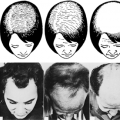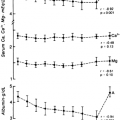DIFFERENTIAL DIAGNOSIS OF CUSHING-TYPE HYPERCORTISOLISM AND PSEUDO–CUSHING SYNDROME
Part of “CHAPTER 75 – CUSHING SYNDROME“
The biochemical and phenotypic presentation of patients with mild hypercortisolism in Cushing syndrome is often indistinguishable from that seen in pseudo-Cushing states such as depression. These include elevated urine free cortisol and 17-hydroxycorticosteroid excretion and abnormalities in the normal suppression of plasma cortisol after the administration of a low (1-mg) dose of dexamethasone. In most cases of pseudo– Cushing syndrome, the history and physical examination provide important clues as to whether a given patient has Cushing syndrome or one of these other clinical states. This is particularly true with regard to obesity, in which comorbid conditions exist that overlap with those of Cushing syndrome. In these cases, biochemical studies are necessary to establish a differential diagnosis. Several of the tests used in this differential diagnosis vary in the level of diagnostic accuracy. The low-dose dexamethasone suppression test has 74% specificity, 69% sensitivity, and 71% diagnostic accuracy using the standard criterion of suppression of urinary 17-hydroxycorticoids to <2.5 mg per day on the second day of suppression. For urinary free cortisol, a value >36 μg per day (100 nmol per day) has 100% specificity, 56% sensitivity, and 71% diagnostic accuracy for Cushing syndrome. The CRH stimulation test without dexamethasone pretreatment has 100% specificity, 64% sensitivity, and 76% diagnostic accuracy. The diagnostic accuracy of the CRH/DST for the diagnosis of Cushing syndrome is greater than the accuracy of either the low-dose dexamethasone test or the CRH test alone.69 A plasma cortisol concentration of >1.4 μg/dL (38 nmol/L) measured 15 min after the administration of CRH had 100% specificity, sensitivity, and diagnostic accuracy. The test has not been worked out for patients with severe melancholic depression, anorexia nervosa, cortisol resistance syndrome, or recent surgical stress. It also has not been defined for patients with periodic hormonogenesis and intermittent Cushing syndrome. In these patients, measurement of repeated 24-hour urine free cortisol levels may help detect times when an upsurge of ACTH and cortisol secretion occurs. The hypothesis behind the test is that at a dexamethasone dose sufficient to suppress normal cortisol production, patients with pseudo-Cushing states exhibit low basal plasma cortisol and ACTH levels and a diminished response to exogenous CRH. By contrast, patients with Cushing disease have higher basal cortisol and ACTH levels after the administration of dexamethasone and a greater peak response after CRH.69
Stay updated, free articles. Join our Telegram channel

Full access? Get Clinical Tree





